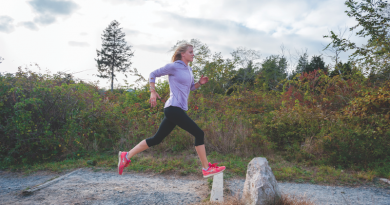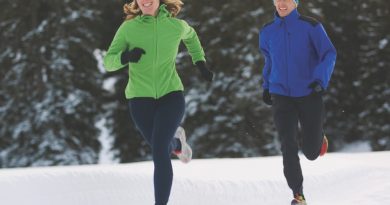To Shoe or Not To Shoe | Local Runners Weigh in on Running’s Biggest Question
Newton Baker enters Capitol Grounds in Montpelier greeting half a dozen friends between the front door and the front counter. The popular, retired elementary school teacher, who taught in the Central Vermont area for 35 years, is a regular at the coffeehouse, holding court on a multitude of topics.
It’s his 30 years as a runner that allows him to weigh in on the continuing debate between old-school traditional-sneaker-clad runners and the new-school minimalists with barely there footwear.
“There are great truths on both sides,” he said, “and both sides overblow and play up their great truths.”
Baker has endured 148 marathons and 30 ultra events that lasted for 24 hours or up to 120 miles. The 70-year-old has done his homework the hard way.
He can discuss proprioceptive muscle response and how overcushioned shoes dampen the feedback we need to get from the bottom of the foot. He spent three years in Africa in the 1960s with the Peace Corps, and his feet were made tough by going barefoot. He accepts the premise that the best natural form for the foot is not to be overshod.
Still, when he heads out for a run, it’s in the most basic pair of New Balances he can find. He’s not interested in messing with what has worked for him for three foot-problem-free decades.
As he said, quoting Dr. George Sheehan from his 1992 book Running to Win: “We are an experiment of one.”
It was a 2009 book called Born to Run that triggered the current resurgence in barefoot running and almost simultaneously stopped the running shoe world in its tracks. No longer were big, pillowy heels and rigid ankle support desired. Instead, consumers began looking for shoes that allowed their feet to feel and respond to the ground underneath them. The latest running shoes are lighter with a significant reduction in ramp angle, the difference in height between the heel and the forefoot.
In the book, Christopher McDougall follows a Mexican tribe of ultrarunners who race 50 to 200 miles straight without shoes and without breaking down from injuries. McDougall persuasively argues that traditional running shoes promote poor running form, resulting in greater impact with each stride and, consequently, more injuries.
Even before McDougall’s book hit, in fact two years before, shoe manufacturer Newton Running began crafting shoes around the concept of “natural running,” in other words, the barefoot running of our youth: short, quick strides, landing at midfoot with the heel settling gently to the ground.
According to the company website, a shorter stride with a midfoot or forefoot landing creates less vertical bounce and less impact with each step. A small Harvard study published earlier this year backs up that claim. It found habitual heel-strikers had approximately twice the rate of repetitive stress injuries of forefoot strikers.
In addition, that style of running is more efficient, said company spokeswoman Elinor Fish, which makes running more enjoyable.
But she was also quick to stress the advice posted prominently on the website and echoed by the medical field: If you’re going to give minimalist running a try, adapt slowly.
“Runners who simply shed all running footwear or go from a traditional shoe with a 15percent gradient to a shoe with a 0percent gradient often incur severe low-leg injuries, then blame the new running style or footwear rather than their own impatience with gradually easing into natural-running-form footwear,” she said.
The physical therapists at Green Mountain Rehabilitation and Sports Medicine in Burlington can attest. They said jumping into the trend too quickly puts much more demand on the muscles, especially the Achilles and calf.
Barefoot runners tend to strike at midfoot rather than the heel, with the springy ball of the foot absorbing much of the impact. With each stride, the calf muscles engage to flex the ankle and, similar to the effects of a long session of jump roping, will require extensive stretching to release the repeated contraction.
Developing proper form takes time—it does not happen as a result of leaving the shoes behind—as does developing strength in the feet and a tough outer layer of callouses.
Making the change gradually worked for Nick Petterssen, who runs The Confluence, a Crossfit-influenced fitness center in Berlin. Petterssen kept his distances under three miles early on, even switching back to his “old cushy running shoe” for a 5K.
He experienced some extra soreness in his calf muscles during the transition, but said overall it was an easy process.
“I have knee issues left over from a volleyball injury (torn ACL and meniscus damage), and I notice that the running technique encouraged by the minimalist shoe leads to less impact on that bad knee,” he said. “I also feel that it helps me achieve better performance, especially over short distances, as my forward lean and hamstring engagement both generate more power and speed in my running stride.
He initially made the switch to a minimalist shoe while looking for better performance in the gym, but it was not long before he was putting them through their paces outside.
“My running is typically done in shorter, high-intensity intervals like 400s and 800s, so it made a lot of sense to be in something that more closely resembled a racing flat,” he said.
He wears shoes from the Inov-8 line for trail running and indoor workouts, and a set of Vibram Five Fingers for pavement and dirt-road running.
Susan Foerster, practice manager at Green Mountain Rehabilitation & Sports Medicine, and physical therapists Eric Elsinger and Christine Hagan said runners have become more aware of the minimalist trend, and they regularly field questions on shoe ramp and weight.
“Generally speaking, those are trends, but they don’t apply to everyone,” Elsinger said.
Green Mountain Rehab offers video analysis and orthotics to help runners find a proper fit, and its on-site store, the Green Mountain Running Medicine Shop, is one of the few in the state that carries Newtons.
The store is the lone outlet in Vermont for the Hoka One One, a trail and running shoe line that follows the low-ramp-angle trend.
Hokas look as heavy and thick-soled as combat boots, but are surprisingly light at about 0.7 of a pound apiece. Unlike the barely there footwear, though, Hokas encase the foot with stability and have a rocker sole: shoe and foot roll forward as one, there is no break across the bridge.
The technology has been a life-changer for people with arthritic toes, Foerster said.
One style of shoe, as with one philosophy, does not fit all, the physical therapists said just about every runner has to compensate for an inherent weakness. Their advice: If you’ve found something that works for you, stick with it.
“You can’t just get better from taking off the shoes,” said Christine Hagan. “Work on form to increase efficiency or speed, maybe more than changing the shoe.”


